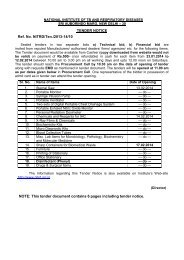The Indian Journal of Tuberculosis - LRS Institute of Tuberculosis ...
The Indian Journal of Tuberculosis - LRS Institute of Tuberculosis ...
The Indian Journal of Tuberculosis - LRS Institute of Tuberculosis ...
Create successful ePaper yourself
Turn your PDF publications into a flip-book with our unique Google optimized e-Paper software.
10 A.K. CHAKRABORTYET AL<br />
statements on the nature <strong>of</strong> working systems,<br />
without resorting to the rigors <strong>of</strong> obtaining<br />
statistical support from co-efficients <strong>of</strong> the effectvariables.<br />
Others like to limit the number <strong>of</strong><br />
variables to be studied, or further verify whether<br />
the nature <strong>of</strong> the findings generated by the model<br />
are in consonance with a prior hypothesis. In<br />
other words, the bounds <strong>of</strong> direct observation are<br />
sought to be extended through constructing<br />
models. <strong>The</strong> present study is an attempt on<br />
similar lines. Its aim is to present the decision<br />
makers a choice in selecting one among the<br />
several alternative courses, worked out by an<br />
interplay <strong>of</strong> several sets <strong>of</strong> variables that could<br />
not have been practicably obtained from<br />
observational studies.<br />
<strong>The</strong> data from several relevant operational<br />
studies have been used by us in seeking to<br />
investigate the role <strong>of</strong> case-finding and treatment<br />
under DTP, at various efficiency levels in the<br />
context <strong>of</strong> tuberculosis control, consequent to the<br />
introduction <strong>of</strong> SCC. <strong>The</strong> model thus constructed<br />
could also be used to compute expectations,<br />
based on the performance <strong>of</strong> some <strong>of</strong> the key<br />
activities in tuberculosis control at some<br />
hypothetically imputed levels, based on user<br />
response and service efficiency. <strong>The</strong>se<br />
expectations, on the other hand, could also set the<br />
process <strong>of</strong> matching the current as well as future<br />
performance <strong>of</strong> DTP, subject to input variations<br />
from time to time.<br />
Material and Methods<br />
<strong>The</strong> model was constructed on a Personal<br />
Computer (PC-XT, ET&T), using LOTUS 1-2-3<br />
s<strong>of</strong>tware package. <strong>The</strong> operational flow chart<br />
considered for the preparation <strong>of</strong> the model is<br />
given in the Figure (P. 11). <strong>The</strong> definitions used<br />
and the ratios and assumptions governing the<br />
flow <strong>of</strong> events in the model, along with the<br />
computed absolute numbers constituting the flow<br />
are as follows :<br />
Prevalence <strong>of</strong> cases in an average district: (A in<br />
Fig.) <strong>The</strong> population size <strong>of</strong> an average <strong>Indian</strong><br />
district is taken as 1.5 million. <strong>The</strong> prevalence <strong>of</strong><br />
sputum culture positive cases among those aged<br />
= >5 years in an average district works out to<br />
5,000, at nearly 4/1,000 (Ref. 6). Case load for<br />
an average DTP : (B in Fig.) <strong>The</strong><br />
case load in an average DTP is the number <strong>of</strong><br />
previously undiagnosed symptomatics reporting<br />
to DTP units and diagnosed as cases. It is<br />
calculated to be approximately 2,500 cases i.e.,<br />
50% <strong>of</strong> the prevalence in the district 7<br />
Potential <strong>of</strong> case-finding : (C in Fig.) It is the<br />
number <strong>of</strong> cases, diagnosable by Ziehl-Neelsen<br />
microscopy 8 , being 80% <strong>of</strong> 2,500 culture positive<br />
case load i.e., 2,000 cases. <strong>The</strong>se cases are taken<br />
to be smear as well culture positive.<br />
Efficiency <strong>of</strong> case-finding : (CF efficiency-D in<br />
Fig.) It is the number or proportion <strong>of</strong> cases that<br />
could be diagnosed out <strong>of</strong> previously undiagnosed<br />
sputum smear positive cases presenting<br />
themselves for diagnosis in a DTP. [At the<br />
average level <strong>of</strong> efficiency <strong>of</strong> 33%, as estimated by<br />
the Monitoring Section <strong>of</strong> National <strong>Tuberculosis</strong><br />
<strong>Institute</strong>, Bangalore 9 (NTI), about 660 cases].<br />
Levels <strong>of</strong> compliance : <strong>The</strong>se are the proportions<br />
<strong>of</strong> doses taken (collected doses are presumed to<br />
have been consumed) out <strong>of</strong> the total due by the<br />
cases put on treatment. <strong>The</strong> levels <strong>of</strong> compliance<br />
for INH-Thiacetazone regimen for standard<br />
chemotherapy 10 (SR) and fully self administered<br />
2ERH/4H2R2 SCC regimen 11 have been<br />
considered for developing the model. <strong>The</strong>se<br />
regimens were selected because valid data on<br />
compliance levels could be computed from them.<br />
<strong>The</strong> levels <strong>of</strong> compliance for treatment are<br />
defined as follows:<br />
In respect <strong>of</strong> SR—expressed as percent <strong>of</strong><br />
collections made out <strong>of</strong> due in one year :<br />
Level 1-up to 25; Levels 2-from 26 to 50;<br />
Levels 3-from 51 to 75; Level 4-from 76 to 100.<br />
In respect <strong>of</strong> SCO-expressed as percent <strong>of</strong><br />
drug collections during the first two months <strong>of</strong><br />
intensive and the following four months <strong>of</strong><br />
continuation phase:<br />
Level 1-less than 80 in both intensive and<br />
continuation phase; Level 2- less than 80 in<br />
intensive phase and more than 80 in continuation<br />
phase; Level 3-more than 80 in intensive phase<br />
and less than 80 in continuation phase; Level 4-<br />
more than 80 in both the phases. Rate <strong>of</strong><br />
Compliance: It is the proportion <strong>of</strong> cases who<br />
take treatment at a given level <strong>of</strong> compliance<br />
(Tables 1 and 2). <strong>The</strong>se proportions are taken<br />
from some operational studies and then rounded<br />
<strong>of</strong>f to the nearest digit in Tables 5 & 6 10 ' 11

















